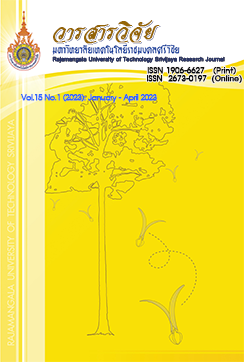Effect of Seed Coating with Biopolymer and Coumarin Derivative on Water Uptake and Germination of Sweet Corn Seed
Keywords:
water uptake, seed coating, poly-gamma-glutamic acid, coumarinAbstract
A desired biopolymer composite for seed coating is eco-friendly without negative effect on seed germination. Seed imbibition is a critical process for successful germination. Therefore, an objective of this research was to investigate water uptake rates of sweet corn seed coated with composites of biopolymers and a new coumarin derivative which is fluorescent that could create seed identity to prevent counterfeit seed. The experiment was laid out in a completely randomized design (CRD) with four replications and six treatments of seed coating as follows: (1) uncoated seeds, (2) seeds coated with poly-γ-glutamic acid (PGA), (3) carboxymethyl cellulose (CMC), (4) commercial polymer (CSC), (5) PGA+CMC+coumarin (PAG+CMC+COU), and (6) CSC+COU. It was found that at the initial of imbibition of 24 hrs, water uptake rates of coated seeds with PGA, CMC and PGA+CMC+COU were not different from those of uncoated seeds while seeds coated with CSC and CSC+COU had the highest water uptake rate. At the imbibition of 66 hrs, when radicle is visible, uncoated seeds had the highest water uptake rate followed by seeds coated with PGA and CMC while seeds coated with CSC, PGA+CMC+COU and CSC+COU had the lowest water uptake rate. However, there were no differences in percentage of radicle emergence, germination and seedling dry weight of uncoated and coated sweet corn seeds with all treatments. The results indicated that the biopolymer and coumarin derivative can be used for seed coating of sweet corn seed and has no effect on seed germination.
References
Abenavoli, M.R., Cacco, G., Sorgona, A., Marabottini, R., Paolacci, A.R., Ciaffi, M. and Badiani, M. 2006. The Inhibitory effects of coumarin on the germination of durum wheat (Triticum turgidum ssp. durum, CV. SIMETO). Journal of Chemical Ecology 32: 488-506.
Al-Amiery, A.A., Kadhum, A.A.H. and Mohamad, A.B. 2012. Antifungal activities of new coumarins. Molecules 17: 5713-5723.
Chanprasert, W. 1994. Seed Physiology. Faculty of Agriculture, Kasetsart University, Bangkok. (in Thai)
Chen, B.X., Peng, Y.X., Gao, J.D., Zhang, Q., Liu, Q.J., Fu, H. and Liu, J. 2019. Coumarin-induced delay of rice seed germination is mediated by suppression of abscisic acid catabolism and reactive oxygen species production. Frontiers in Plant Science 10: 1-12.
Daungpattra, J. 1986. Seed Testing and Analysis. Agri Book Group, Bangkok. (in Thai)
Gorim, L. and Asch, F. 2017. Seed coating increases seed moisture uptake and restricts embryonic oxygen availability in germinating cereal seeds. Biology 6: 1-14.
IRRI. 2018. Statistical tool for agricultural research. International Rice Research Institute, Manila, Philippines.
ISTA. 2020. International rules for seed testing. Seed Science and Technology. The International Seed Testing Association, Bassersdof, Switzerland.
Kaewsorn, P., Boonyuen, P. and Chulaka, P. 2014. Preliminary study of physical characteristic and imbibition of some cucurbit seeds. Agricultural Science Journal 45: 549-552. (in Thai)
Lee, H.K., Oh, S.R., Kwon, O.K., Ahn, K.S., Lee, J., Kim, J.C., Min, B.S. and Joung, H. 2007. Isolation of coumarins and ferulate from the roots of angelica purpuraefolia and the antitumor activity of khellactone. Wiley Interscience 21: 406-409.
Lupini, A., Araniti, F., Sunseri, F. and Abenavoli, M.R. 2014. Coumarin interacts with auxin polar transport to modify root system architecture in Arabidopsis thaliana. Plant Growth Regulation 74: 23-31.
Marcus, A. 1969. Kinetics of water uptake by seeds. Symposia of the Society for Experimental Biology 23: 143-160.
Montagner, C., de Souza, S.M., Groposo, C., Delle Monache, F., Smânia, E.F. and Smânia, A. 2008. Antifungal activity of coumarins. Zeitschrift für Naturforschung 63: 21-28.
Phupamok, B. 2008. Providing a quality assurance label for quality seed shops to improve seed industrial standard of Thailand. Technologychaoban 443: 70-71. (in Thai)
Poonsawas, K. 2019. Investigation and development of seed coating from poly--glutamic acid and coumarin derivative. Special problem. Bachelor of Science (Chemistry), Kasetsart University, Kamphaeng Saen Campus. (in Thai)
Shih, I.L. and Van, Y.T. 2001. The production of poly-(γ-glutamic acid) from microorganisms and its various applications. Bioresource Technology 79: 207-225.
Siri, B. 2009. Seed Science. Faculty of Agriculture, Khon Kaen University, Khon Kaen. (in Thai)
Tian, Y., Guan, B., Zhou, D., Yu, J., Li, G. and Lou, Y. 2014. Responses of seed germination, seedling growth, and seed yield traits to seed pretreatment in maize (Zea mays L.). The Scientific World Journal 2014: 834630.
Wan, L.S.C. and Lee, P.F.S. 1974. CMC of polysorbates. Journal of Pharmaceutical Sciences 63: 136-137.
Wilson, D.O. and Mohan, S.K. 1998. Unique seed quality problems of sh2 sweet corn. Seed Technology 20: 176-186.
Woodstock, L.W. 1988. Seed imbibition: A critical period for successful germination. Journal of Seed Technology 12: 1-15.
Yildirim, M. 2020. Effects of coating treatment with aloe vera and glycerol on germination delay and seed viability of wheat under different water levels. Journal of Agriculture and Nature 23: 994-1004.
Downloads
Published
How to Cite
Issue
Section
License
Copyright (c) 2023 Rajamangala University of Technology Srivijaya Research Journal

This work is licensed under a Creative Commons Attribution-NonCommercial-NoDerivatives 4.0 International License.
The content and information in the article published in Journal of Rajamangala University of Technology Srivijaya It is the opinion and responsibility of the author of the article. The editorial journals do not need to agree. Or share any responsibility.







